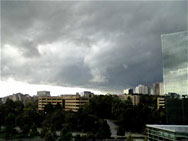Bulova: Tysons $15 billion is false
Fairfax County Chairman Sharon Bulova has published a rebuttal to last week’s Post story claiming that the proposed Tysons Corner development will demand $15 billion in extra infrastructure investment. As we reported, that figure includes plenty of infrastructure unrelated or at best peripherally related to Tysons. Bulova writes:
An article in The Washington Post on Friday, October 30, 2009, “Tysons will need $15 billion — ‘with a B’” gives the impression that the costs for “Transforming Tysons” will break the bank and makes the changes unwise. Neither is true and it’s important to put the order of magnitude cost estimates as presented by County staff last week, in context.
Starting with the $14.8 billion figure in staff’s charts for “Projects Serving Tysons 2010 - 2030 and 2030 - 2050.” Of this:
- $5.5 billion is for the Dulles Metrorail Silver line capital costs ($5.2 B), funding for which is already accounted for through tolls, federal funding, and special tax districts for commercial land owners in the area. Operating costs are estimated at ($0.3 B) over 40 years.
- $5.4 billion is for the future westward extension of the I-66 Metrorail line. Also included in this figure is an estimate for another Metrorail or other high capacity transit system extension in the County (location not yet identified). This figure includes estimates for commuter parking facilities outside of Tysons, and express bus service on the Beltway HOT lanes, I-66, and other major corridors, some of which will carry passengers to Tysons.
- $1.2 billion is for the proposed grid of streets within Tysons, including the costs of land. These costs will be captured in large part as development occurs.
Which leaves:
$2.7 billion in estimated transit and roadway capital and operating costs associated with the Tysons Plan over a 40-year period of time.
The Tysons Plan is a 40-year Plan. While $2.7 billion over the next 40 years sounds like a large number, it breaks down to $67 million per year. This figure includes operational costs for enhanced bus service and a new circulator in Tysons, some of which will be paid in fares by riders.
Our region has grown and prospered over the past 40 years. We will continue to grow during the next 40 years. Some of that growth will be in Fairfax County.
When we look back forty years to 1969, Fairfax County had a population of roughly 500,000 people. Since that time, working with the state, the federal governments and landowners, we have made transportation improvements to support our growing population:
- building the entire regional Metrorail system including the extensions to Franconia-Springfield, Huntington, and Vienna in Fairfax County,
- implementing the Fairfax Connector bus service,
- widening the Capital Beltway, I-66, and I-95 multiple times,
- building the Dulles Toll Road, the Fairfax County Parkway, the Springfield Mixing Bowl, and
- countless other roadway widening, intersection, and grade-separated interchange improvements.
Today with a population of nearly 1.2 million, we are planning ahead for how we will accommodate our future growth in a way that addresses the challenges our past growth patterns have presented us with. What is particularly important about the Tysons Vision is that growth is oriented around mass transit and represents a shift in our planning paradigm. Tysons will be an urban growth center created to be less reliant on the automobile. It will provide people with multiple transportation options. The plan proposed by County staff calls for reducing car trips in and out of Tysons by 65%.
More urban mixed use transit-oriented land-use patterns, in addition to our single family subdivisions, will provide County residents with a diversity of life style choices at all stages in life. By offering more transit-oriented urban-style communities as we prepare for our future growth, we will be able to better address the transportation and environmental challenges that plague us today.

